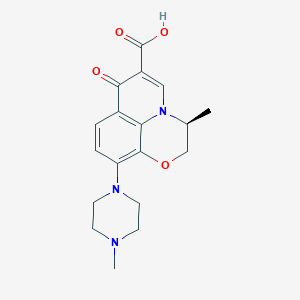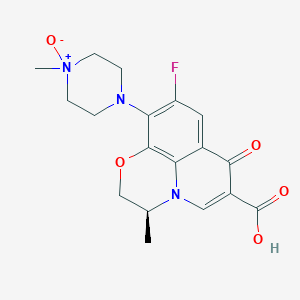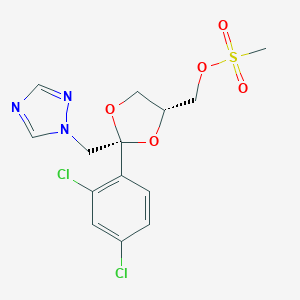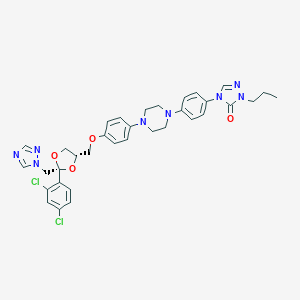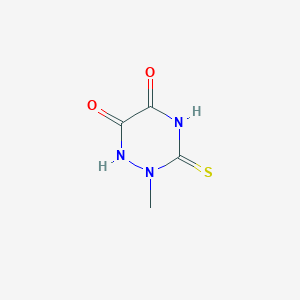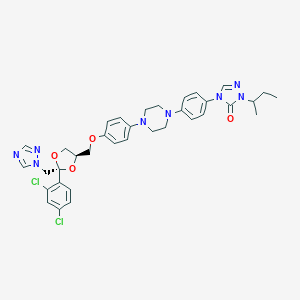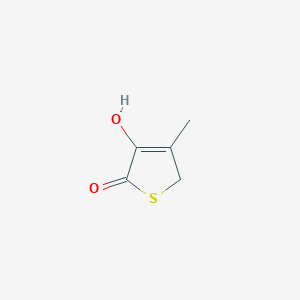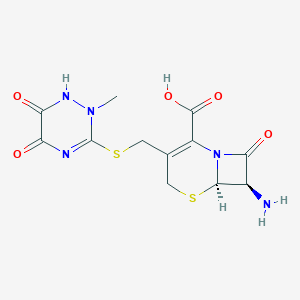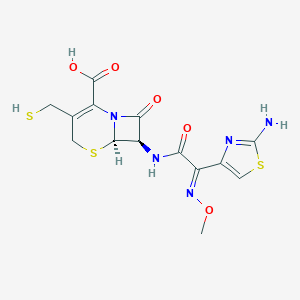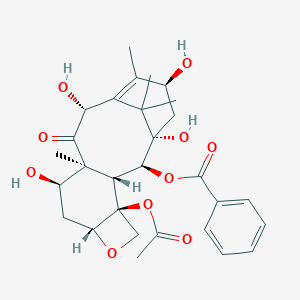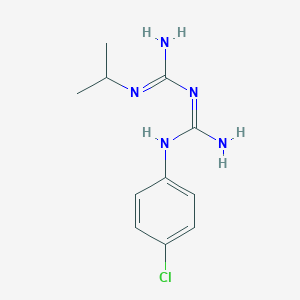
氯胍
描述
盐酸氯胍 D6: 是盐酸氯胍的氘标记衍生物,盐酸氯胍是一种抗疟疾药物。 盐酸氯胍广泛用于预防和治疗由恶性疟原虫和间日疟原虫引起的疟疾 . 盐酸氯胍 D6 中的氘标记增强了其稳定性,并允许进行更精确的药代动力学研究 .
科学研究应用
盐酸氯胍 D6 具有广泛的科学研究应用,包括:
作用机制
生化分析
Biochemical Properties
Proguanil is a biguanide derivative that is converted to an active metabolite called cycloguanil . It exerts its antimalarial action by inhibiting the enzyme, dihydrofolate reductase, which is involved in the reproduction of the malaria parasite, Plasmodium falciparum and Plasmodium vivax . This inhibition blocks the biosynthesis of purines and pyrimidines, which are essential for DNA synthesis and cell multiplication .
Cellular Effects
Proguanil works by stopping the malaria parasite, Plasmodium falciparum and Plasmodium vivax, from reproducing once it is in the red blood cells . It does this by inhibiting the enzyme, dihydrofolate reductase, which is involved in the reproduction of the parasite . This leads to failure of nuclear division at the time of schizont formation in erythrocytes and liver .
Molecular Mechanism
The molecular mechanism of Proguanil involves the inhibition of the enzyme dihydrofolate reductase of plasmodia . This inhibition blocks the biosynthesis of purines and pyrimidines, which are essential for DNA synthesis and cell multiplication . This leads to failure of nuclear division at the time of schizont formation in erythrocytes and liver .
Temporal Effects in Laboratory Settings
Proguanil has been shown to have potent, but slow-acting, in vitro anti-plasmodial activity . The potent fast-acting activity of proguanil is attributed to the dihydrofolate reductase inhibitor cycloguanil .
Dosage Effects in Animal Models
While specific dosage effects of Proguanil in animal models were not found in the search results, it is known that Proguanil is extensively absorbed in rats . In both species, toxicity was related to proguanil exposure, the principal manifestations being salivation, emesis, and loss of body weight .
Metabolic Pathways
Proguanil is variably metabolized in the liver by cytochrome P450 isoenzymes to the active triazine metabolite, cycloguanil . This variable metabolism of proguanil may have profound clinical importance in poor metabolizers such as the Asian and African populations at risk for malaria infection .
Transport and Distribution
Proguanil and its metabolite cycloguanil were found to be substrates of organic cation transporter 1 (OCT1), organic cation transporter 2 (OCT2), multidrug and toxin extrusion 1 (MATE1) and multidrug and toxin extrusion 2-K (MATE2-K) . These transporters play a crucial role in the distribution and excretion of Proguanil .
Subcellular Localization
The specific subcellular localization of Proguanil was not found in the search results. Given its mechanism of action, it can be inferred that Proguanil likely localizes to the site of the enzyme dihydrofolate reductase, which is involved in the reproduction of the malaria parasite .
准备方法
合成路线和反应条件: : 盐酸氯胍 D6 的合成涉及将氘原子掺入盐酸氯胍分子中。 这可以通过多种方法实现,包括在合成过程中使用氘代试剂或溶剂 . 反应条件通常涉及使用氘代溶剂,如氘代二甲基亚砜 (DMSO) 或氘代乙醇,反应在受控的温度和压力下进行,以确保氘原子的掺入 .
工业生产方法: : 盐酸氯胍 D6 的工业生产遵循类似的合成路线,但规模更大。 该工艺涉及使用自动化反应器并精确控制反应条件,以确保最终产品的高收率和纯度 .
化学反应分析
相似化合物的比较
类似化合物
盐酸氯胍: 盐酸氯胍 D6 的母体化合物,用于疟疾预防和治疗.
环氯胍: 盐酸氯胍的活性代谢物,通过氧化形成.
氯喹: 另一种抗疟疾药物,通常与盐酸氯胍联合使用.
独特性: : 盐酸氯胍 D6 由于其氘标记而独一无二,这增强了其稳定性,并允许与非氘标记的对应物相比进行更精确的药代动力学研究 . 这使得它成为科学研究和药物开发中宝贵的工具。
属性
| Proguanil inhibits the dihydrofolate reductase of plasmodia and thereby blocks the biosynthesis of purines and pyrimidines, which are essential for DNA synthesis and cell multiplication. This leads to failure of nuclear division at the time of schizont formation in erythrocytes and liver. | |
CAS 编号 |
500-92-5 |
分子式 |
C11H16ClN5 |
分子量 |
259.77 g/mol |
IUPAC 名称 |
1-[amino-(4-chloroanilino)methylidene]-2-(1,1,1,3,3,3-hexadeuteriopropan-2-yl)guanidine |
InChI |
InChI=1S/C11H16ClN5/c1-7(2)15-10(13)17-11(14)16-9-5-3-8(12)4-6-9/h3-7H,1-2H3,(H5,13,14,15,16,17)/i1D3,2D3 |
InChI 键 |
SSOLNOMRVKKSON-WFGJKAKNSA-N |
SMILES |
CC(C)N=C(N)N=C(N)NC1=CC=C(C=C1)Cl |
手性 SMILES |
[2H]C([2H])([2H])C(C([2H])([2H])[2H])N=C(N)N=C(N)NC1=CC=C(C=C1)Cl |
规范 SMILES |
CC(C)N=C(N)N=C(N)NC1=CC=C(C=C1)Cl |
熔点 |
129 °C |
| 500-92-5 | |
物理描述 |
Solid |
纯度 |
> 95% |
数量 |
Milligrams-Grams |
相关CAS编号 |
637-32-1 (hydrochloride) |
溶解度 |
2.86e-01 g/L |
同义词 |
Bigumal Chlorguanid Chloriguane Chloroguanide Chloroguanide Hydrochloride Hydrochloride, Chloroguanide Hydrochloride, Proguanil Paludrin Paludrine Proguanil Proguanil Hydrochloride |
产品来源 |
United States |
Retrosynthesis Analysis
AI-Powered Synthesis Planning: Our tool employs the Template_relevance Pistachio, Template_relevance Bkms_metabolic, Template_relevance Pistachio_ringbreaker, Template_relevance Reaxys, Template_relevance Reaxys_biocatalysis model, leveraging a vast database of chemical reactions to predict feasible synthetic routes.
One-Step Synthesis Focus: Specifically designed for one-step synthesis, it provides concise and direct routes for your target compounds, streamlining the synthesis process.
Accurate Predictions: Utilizing the extensive PISTACHIO, BKMS_METABOLIC, PISTACHIO_RINGBREAKER, REAXYS, REAXYS_BIOCATALYSIS database, our tool offers high-accuracy predictions, reflecting the latest in chemical research and data.
Strategy Settings
| Precursor scoring | Relevance Heuristic |
|---|---|
| Min. plausibility | 0.01 |
| Model | Template_relevance |
| Template Set | Pistachio/Bkms_metabolic/Pistachio_ringbreaker/Reaxys/Reaxys_biocatalysis |
| Top-N result to add to graph | 6 |
Feasible Synthetic Routes
Q1: How does Proguanil exert its antimalarial effect?
A1: Proguanil itself has weak antimalarial activity. Its effectiveness stems from its active metabolite, Cycloguanil, a potent inhibitor of dihydrofolate reductase (DHFR) []. DHFR is a crucial enzyme in the folate metabolic pathway, essential for DNA synthesis and cellular replication in parasites like Plasmodium falciparum []. By inhibiting DHFR, Cycloguanil disrupts DNA synthesis and ultimately kills the parasite [, ].
Q2: Are there other mechanisms by which Proguanil impacts Plasmodium falciparum?
A2: Research suggests Proguanil, in combination with Atovaquone, might interfere with mitochondrial electron transport and collapse mitochondrial membrane potential in the parasite, further contributing to its antimalarial activity [].
Q3: Does Proguanil affect other stages of the Plasmodium life cycle besides the erythrocytic stage?
A3: Yes, both Proguanil and Atovaquone demonstrate activity against gametocytes and pre-erythrocytic (hepatic) stages of malaria parasites []. This is supported by studies indicating that short-term Proguanil administration might provide causal prophylaxis for Plasmodium vivax by inhibiting liver-stage schizonts, although it doesn't seem to prevent late attacks related to hypnozoite reactivation [].
Q4: How is Proguanil metabolized in the human body?
A4: Proguanil is primarily metabolized in the liver by cytochrome P450 (CYP) enzymes, specifically CYP2C19 and CYP3A4 [, ]. The primary metabolic pathway involves CYP2C19-mediated conversion to its active metabolite, Cycloguanil [, ].
Q5: What factors contribute to the variability in Proguanil metabolism among individuals?
A5: Inter-individual variability in Proguanil metabolism is influenced by several factors, primarily genetic polymorphisms in the CYP2C19 gene [, ]. Individuals homozygous for the CYP2C19*2 allele exhibit significantly reduced metabolic capacity, leading to higher Proguanil and lower Cycloguanil levels []. Other factors include co-administration of drugs that are CYP2C19 inducers or inhibitors [], and variations in the expression and activity of other enzymes involved in Proguanil metabolism, like CYP3A4 [].
Q6: How is Proguanil eliminated from the body?
A6: Both Proguanil and Cycloguanil are predominantly eliminated through the kidneys []. Therefore, dosage adjustments are necessary for patients with renal impairment to prevent drug accumulation [].
Q7: Are there documented cases of resistance to Proguanil?
A7: Yes, Proguanil resistance has been observed and is primarily attributed to point mutations in the dihydrofolate reductase (DHFR) gene of Plasmodium falciparum [, ]. The S108N mutation is particularly associated with Proguanil resistance [, ].
Q8: Is there cross-resistance between Proguanil and other antimalarial drugs?
A8: Yes, cross-resistance has been observed between Proguanil and Pyrimethamine, another antifolate drug []. This is attributed to their shared mechanism of action, both targeting the DHFR enzyme in the parasite. The presence of the triple mutant DHFR haplotype (S108N+N51I+C59N) in Plasmodium falciparum has been linked to resistance to both drugs [, ].
Q9: Does Proguanil interact with other drugs?
A9: Yes, Proguanil's metabolism can be affected by co-administration with other drugs metabolized by CYP2C19, such as Phenytoin []. Concomitant use of Phenytoin, a CYP2C19 inducer, can decrease Proguanil's area under the curve (AUC) and maximum concentration (Cmax), potentially impacting its efficacy [].
Q10: Beyond malaria, are there other potential therapeutic applications for Proguanil?
A10: Emerging research suggests that Proguanil may have anti-cancer properties, particularly in breast cancer. Studies have shown that Proguanil inhibits the growth of breast cancer cells in vitro and in vivo, potentially by inducing oxidative stress, disrupting mitochondrial function, and triggering apoptosis [, ].
Q11: What are the key considerations in formulating Proguanil for therapeutic use?
A11: Proguanil formulations aim to optimize solubility, bioavailability, and stability []. The choice of excipients and manufacturing processes can significantly influence these factors. For instance, some herbal formulations may significantly impact the dissolution profile of Proguanil tablets, potentially altering its bioavailability and warranting further investigation for potential herb-drug interactions [].
Q12: What analytical techniques are commonly employed to quantify Proguanil and its metabolites?
A12: High-performance liquid chromatography (HPLC) is widely used to measure Proguanil and its metabolites in biological samples like plasma and urine [, , ]. Ultra-performance liquid chromatography (UPLC) offers enhanced speed and sensitivity for pharmacokinetic studies [].
体外研究产品的免责声明和信息
请注意,BenchChem 上展示的所有文章和产品信息仅供信息参考。 BenchChem 上可购买的产品专为体外研究设计,这些研究在生物体外进行。体外研究,源自拉丁语 "in glass",涉及在受控实验室环境中使用细胞或组织进行的实验。重要的是要注意,这些产品没有被归类为药物或药品,他们没有得到 FDA 的批准,用于预防、治疗或治愈任何医疗状况、疾病或疾病。我们必须强调,将这些产品以任何形式引入人类或动物的身体都是法律严格禁止的。遵守这些指南对确保研究和实验的法律和道德标准的符合性至关重要。


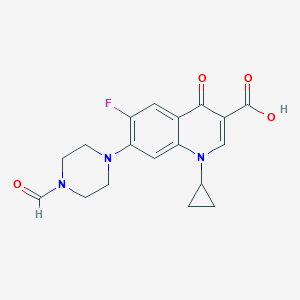
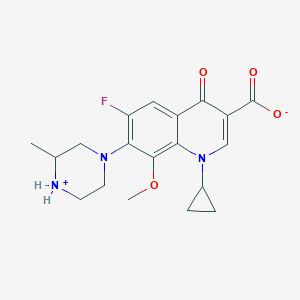
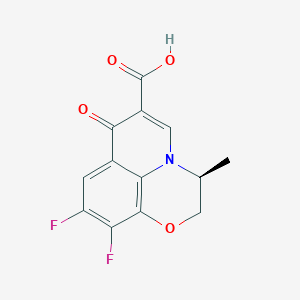
![Ethyl 9-fluoro-3-methyl-10-(4-methylpiperazin-1-yl)-7-oxo-3,7-dihydro-2H-[1,4]oxazino[2,3,4-ij]quinoline-6-carboxylate](/img/structure/B193971.png)
